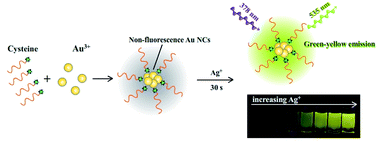Highly selective and rapid detection of silver ions by using a “turn on” non-fluorescent cysteine stabilized gold nanocluster probe†
Abstract
Cysteine is widely used as a stabilizer for the preparation of fluorescent gold nanoclusters (Au NCs) with different fluorescence properties. Herein, by using cysteine as a stabilizer and controlling the synthesis conditions, a new non-fluorescent cysteine stabilized gold nanocluster (Cys-Au NCs) probe was prepared and a new strategy for “turning on” the fluorescence of the Cys-Au NCs was studied for rapid and selective detection of silver ions. In this strategy, the addition of silver ions to non-fluorescent Cys-Au NCs solution could quickly induce a visible fluorescence “turn on” phenomenon in 30 s. Further studies indicated that this fluorescence “turn on” phenomenon is specific for silver ions and the “turn on” fluorescence intensity has a linear relationship with the amount of silver ions in the range from 3.0 to 30.0 μM. Therefore, the non-fluorescent Cys-Au NCs were applied to the detection of silver ions in environmental water samples and a limit of detection (LOD) of 0.26 μM was obtained. This research sheds light on new applications of Au NCs and proposes a simple, rapid, sensitive, and visual method for the detection of metal ions.

- This article is part of the themed collection: Analytical Methods HOT Articles 2021


 Please wait while we load your content...
Please wait while we load your content...